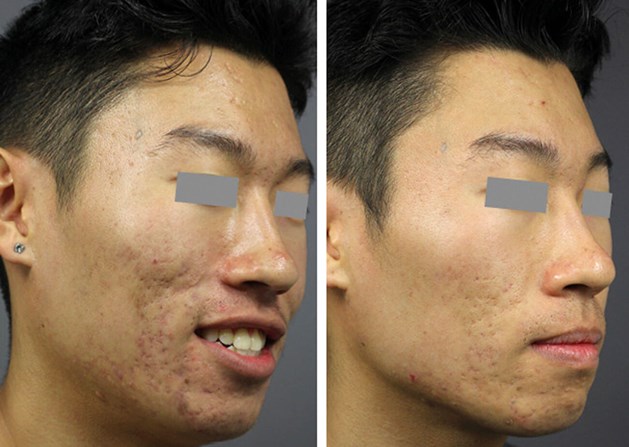Leading Acne Treatment for Sensitive Skin: Gentle Solutions for Clear Skin
Leading Acne Treatment for Sensitive Skin: Gentle Solutions for Clear Skin
Blog Article
Discovering Skin Problem: Identifying and Treating Acne Scars for Healthier Skin
Acne scars represent a significant concern for people looking for to preserve healthy skin, as they can affect both look and self-worth. Recognizing the numerous types of scars, from atrophic to hypertrophic, is essential for determining ideal therapy options.
Comprehending Acne Marks

The body's all-natural healing process can lead to either atrophic marks, which look like anxieties in the skin, or hypertrophic marks, which are elevated and result from overproduction of collagen. Furthermore, the psychological toll of acne scars should not be ignored; numerous people report sensations of humiliation, anxiousness, and decreased self-esteem. This emotional burden can impact social interactions and total lifestyle.
Dealing with acne scars calls for an extensive understanding of their formation and impact. Understanding of the capacity for lasting effects related to untreated scars can encourage people to look for ideal therapies. Early treatment and reliable monitoring approaches can significantly improve skin look and improve mental durability, highlighting the significance of comprehending the intricacies bordering acne marks.
Sorts Of Acne Scars
Acne marks can be classified right into unique types, each exhibiting one-of-a-kind qualities and requiring particular treatment methods. acne treatment for sensitive skin. The primary kinds of acne marks include atrophic, hypertrophic, and keloid scars

Hypertrophic scars, on the other hand, are raised above the skin degree and are the result of too much collagen production throughout the healing process. They typically stay within the borders of the original acne lesion. Keloid marks are comparable but prolong past the initial injury website, forming larger, raised areas that can be painful or scratchy.
Comprehending these sorts of marks is necessary for choosing appropriate treatment alternatives. Different scars might respond much better to certain therapies, such as laser therapies, fillers, or medical treatments, highlighting the importance of a tailored strategy to acne mark monitoring.
Identifying Your Scars
Acne marks usually fall into two groups: hypertrophic and atrophic scars. These can even more be identified into ice-pick scars, boxcar marks, and rolling marks, each exhibiting distinct qualities and calling for various approaches for assessment.
Hypertrophic scars, on the other hand, are increased and use this link take place as a result of excessive collagen production throughout the recovery procedure. Identifying the specific features of your scars-- such as texture, size, and deepness-- is crucial for correct recognition (acne scars). Additionally, consider the distribution of marks throughout your skin, as this can suggest the extent and period of the acne problem
Involving with a skin doctor can give beneficial understandings into the nature of your content scars, aiding in the distinction between different kinds. A comprehensive understanding of your scars will inevitably bring about a much more tailored and effective therapy plan, guaranteeing a clearer and much healthier skin tone.
Treatment Alternatives Readily Available
Determining the specific kind of acne marks existing on your skin prepares for exploring reliable treatment options. Usual sorts of acne scars consist of atrophic (clinically depressed), hypertrophic (raised), and post-inflammatory erythema.
For atrophic scars, options such as chemical peels, microneedling, and laser resurfacing are commonly used. Chemical peels off make use of acids to eliminate the outer layer of skin, promoting brand-new cell development.
Hypertrophic marks can be treated with corticosteroid injections to squash the scar or laser treatment to decrease soreness and improve look. Silicone gel sheets and stress dressings may also help in handling elevated marks.
In enhancement, dermal fillers can briefly load in depressions from atrophic scars, while surgical excision may be suitable for serious cases. Each therapy alternative has its benefits and factors to consider, making it important to seek advice from a skin specialist. They can supply personalized suggestions based upon the kind and severity of your scars, additional hints in addition to your skin kind and total health.
Tips for Prevention
Efficient avoidance strategies can considerably minimize the probability of establishing acne scars. Using non-comedogenic products aids avoid blocked pores, which can intensify acne.
Preventing need to pick or stand out acne lesions is essential, as this can bring about much deeper skin damage and enhance the risk of scarring. Rather, take into consideration utilizing a cold compress or over-the-counter therapies to minimize swelling and inflammation.
Sun defense is another vital element of prevention; ultraviolet (UV) rays can darken marks and hinder the recovery procedure. Using a broad-spectrum sunscreen with at least SPF 30 daily can secure the skin and promote also healing.
Finally, maintaining a balanced diet plan abundant in minerals, vitamins, and anti-oxidants supports skin health and recovery. Staying moisturized and managing stress and anxiety levels can likewise play a significant role in lowering acne flare-ups. By implementing these strategies, individuals can dramatically minimize their opportunities of developing acne scars.
Verdict
In verdict, understanding and determining acne marks is crucial for effective therapy and accomplishing much healthier skin. Different kinds of acne scars, including atrophic and hypertrophic marks, demand certain interventions tailored to specific needs.
The body's natural recovery procedure can result in either atrophic scars, which show up as anxieties in the skin, or hypertrophic scars, which are increased and result from overflow of collagen. They are more separated into three subtypes: ice pick scars, boxcar marks, and rolling scars. Acne scars generally drop into 2 classifications: atrophic and hypertrophic marks. These can better be classified into ice-pick scars, boxcar scars, and rolling marks, each showing distinctive features and calling for various strategies for analysis.
Different types of acne scars, consisting of hypertrophic and atrophic marks, require specific interventions customized to specific requirements.
Report this page